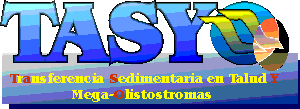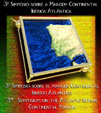http://allserv.rug.ac.be/~pvrensbe/
http://geocities.com/mobilesediment/
The aim of the conference is to document and discuss all aspects of subsurface sediment deformation within large shale sequences. Such deformation includes :
 NEWS
NEWS
![]() Symposium
on Mobile Sediments
Symposium
on Mobile Sediments
http://allserv.rug.ac.be/~pvrensbe/
http://geocities.com/mobilesediment/
The aim of the conference
is to document and discuss all aspects of subsurface sediment deformation
within large shale sequences. Such deformation includes :
soft sediment deformation at shallow burial depth,
mobilisation of overpressured shale in shale diapirs,
injection of clastic dykes and sills,
expulsion of material in mud volcanoes,
etc…
This deformation may occur in response to sedimentary loading, overpressure increase or diagenetic alterations and is commonly influenced by the regional tectonic stress regime.
Large-scale deformation often controls the structural style and fluid dynamics of the sedimentary basin whereas on a smaller scale reservoir properties are severely affected by post-depositional sediment mobilisation and the sealing capacity of clay for hydrocarbon reservoirs or long-time storage of hazardous waste risks to be misjudged
The ever-increasing
resolution of subsurface data generated many new observations that are
sometimes difficult to interprete and don't always fit the classical theorem.
During the conference we hope to bring together these observations before
an interested multi-disciplinary audience to try to advance our understanding
of
subsurface sediment
mobilisation.
![]() OCEAN
MARGINS SESSION AT THE GEOLOGICAL SOCIETY OF AMERICA/GEOLOGICAL
SOCIETY OF LONDON "EARTH SYSTEM PROCESSES" INTERNATIONAL MEETING.
JUNE 24TH-28TH 2001
OCEAN
MARGINS SESSION AT THE GEOLOGICAL SOCIETY OF AMERICA/GEOLOGICAL
SOCIETY OF LONDON "EARTH SYSTEM PROCESSES" INTERNATIONAL MEETING.
JUNE 24TH-28TH 2001
VENUE: EDINBURGH
INTERNATIONAL CONFERENCE CENTRE.
http://www.geosociety.org/meetings/edinburgh/index.htm
TECTONIC AND
SEDIMENTARY PROCESS INTERACTION AT GLOBAL OCEAN MARGINS: FUTURE SCIENCE
STRATEGIES
![]() INTERNATIONAL
OCEAN MARGIN SESSION AT THE EUROPEAN
UNION OF GEOSCIENCES, STRASBOURG - FRANCE 8th - 12th April 2001 ON
"CONTINENTAL SLOPE STABILITY (COSTA) OF OCEAN MARGINS - ACHIEVEMENTS
AND CHALLENGES".
INTERNATIONAL
OCEAN MARGIN SESSION AT THE EUROPEAN
UNION OF GEOSCIENCES, STRASBOURG - FRANCE 8th - 12th April 2001 ON
"CONTINENTAL SLOPE STABILITY (COSTA) OF OCEAN MARGINS - ACHIEVEMENTS
AND CHALLENGES".
Kindly be aware
of the website (http://eost.u-strasbg.fr/EUG)
and E- Rifted Margins. The session will provide an international forum
to present and discuss slope stability on Ocean Margins. See also Website
of the Ocean Margin Deep-Water Research Consortium (OMARC) (http://www.costa-europe.org/).
![]() "Geological Processes on Deep-Water European Margins" - International
Conference and 10th Anniversary TTR Post-Cruise Meeting
"Geological Processes on Deep-Water European Margins" - International
Conference and 10th Anniversary TTR Post-Cruise Meeting
Herewith, I am pleased
to announce "Geological Processes on Deep-Water European Margins" -
International Conference and 10th Anniversary Training Through Research
Post-Cruise Meeting to be held in Moscow and in the
suburbs of Moscow,
Russia between 28 January and 3 February 2001.
The Conference will
be focussed on all aspects of marine geosciences that have been studied
by TTR for the last 10 years. The idea is to obtain a nice overview of
the scientific results of TTR Programme that has been successfully operated
at sea around Europe for already 10 years - under the auspices of UNESCO/IOC
and with the efforts and contributions of all of us.
The preliminary
list of Sessions is planned as following:
1. Deep-sea depositional
systems and modern analogues of hydrocarbon
reservoirs.
2. Shallow gas,
cold seeps and gas hydrates.
3. Diapirism, mud
volcanism, and hydrocarbon potential of deep sedimentary
basins.
4. Slope stability
and geo-hazards.
5. Geomorphology
and neo-tectonics.
6. Biosphere-geosphere
interaction.
7. Pelagic and hemipelagic
sedimentation.
This is just a preliminary
list. In case there will be enough talks on other topics, we will make
additional sessions. I hope, your ideas and suggestions will help us to
make the scientific programme of the Conference fascinating
and beneficial for
everybody.
The results of the
Conference will be published in a special issue of one of the international
journals. Participants, interested in such a publication, will be expected
to bring first drafts of the manuscripts with them to Moscow.
![]() OS07
Geosphere-Biosphere Coupling: Cold Seep Related Carbonate Mound Formation
and Ecology (Joint With Biogeosciences) .
OS07
Geosphere-Biosphere Coupling: Cold Seep Related Carbonate Mound Formation
and Ecology (Joint With Biogeosciences) .
Fall
2000 AGU meeting in San Francisco (December 15-19, 2000)
We are pleased to announce a special session to be held at the Fall 2000 AGU meeting in San Francisco (December 15-19, 2000) : Carbonate mounds are prominent reef types during Earth history since Cambrian times. These mounds frequently form giant host rocks for hydrocarbon accumulation. Recent discoveries of spectacular modern carbonate mounds along the United States, African, Asian, and European continental margin provide an outstanding opportunity to study the sedimentary processes of these buildups. Seepage of hydrocarbons may play a role, although a link with fluid expulsion from depth is still poorly understood. As present-day mound provinces occur at or near areas of increased exploration for hydrocarbons, there is an obvious need to better understand their occurrence, origin, and possible relationship to cold seepage or hydrocarbon leakage, as well as to establish their potential impact on seabed stability and relationship to external forcing mechanisms such as climatic change effects.
The session is envisaged
to contain contributions originating from studies on carbonate mounds and
their ecology mainly in hydrocarbon provinces over the world. We foresee
many new and interesting contributions, in particular in view of the splendid
material obtained e.g. through the recentmost joint cruises carried out
in the framework of the European Union projects ECOMOUND, GEOMOUND
and ACES (Atlantic Coral Ecosystem Study), or in the framework of the IOC/UNESCO
Training Through Research programme. But spectacular new data have also
been collected on various other margins too, off Australia (ODP), Canada,
US, Brazil, Angola, etc.,
and we also look
forward for contributions from related gas hydrate research (hydrate -
carbonate systems and habitats, off Oregon,Cadiz Bay, Gulf of Mexico, etc.).
Giant carbonate mounds are also in the pipe of an ODP proposal and of various
initiatives for submarine dives and ROV cruises, so the topic is quite
timely.
In such a booming
research field, it is very important that the mounds/seeps community would
seize this opportunity for exchanging the recentmost information and for
tuning ongoing and planned actions, worldwide. The AGU special
session offers the
most immediate platform for these objectives, and we truly would encourage
you and your research partners to join and submit a contribution.
Please pay attention
to the fact that the abstract deadline is Friday, September 1, 2000 for
mailed submissions and Thursday, September 7, 2000 for web submissions.
For more information on the meeting and abstract submission, please visit
the AGU
website (http://www.agu.org). Please also send copies of the abstracts
to the convenors.
![]()
 WS2
Structure and Tectono-Sedimentary Dynamics of the Gulf of Cadiz
3rd Symposium on the Atlantic Iberian Margin, Faro, Portugal, September
2000
WS2
Structure and Tectono-Sedimentary Dynamics of the Gulf of Cadiz
3rd Symposium on the Atlantic Iberian Margin, Faro, Portugal, September
2000
![]() Workshop
sobre a Estrutura e Dinâmica Sedimentar do Golfo de Cádiz
(Reunião do Bacalhau) 25-26 February, 1999; Faro, Algarve University
(Portugal)
Workshop
sobre a Estrutura e Dinâmica Sedimentar do Golfo de Cádiz
(Reunião do Bacalhau) 25-26 February, 1999; Faro, Algarve University
(Portugal)